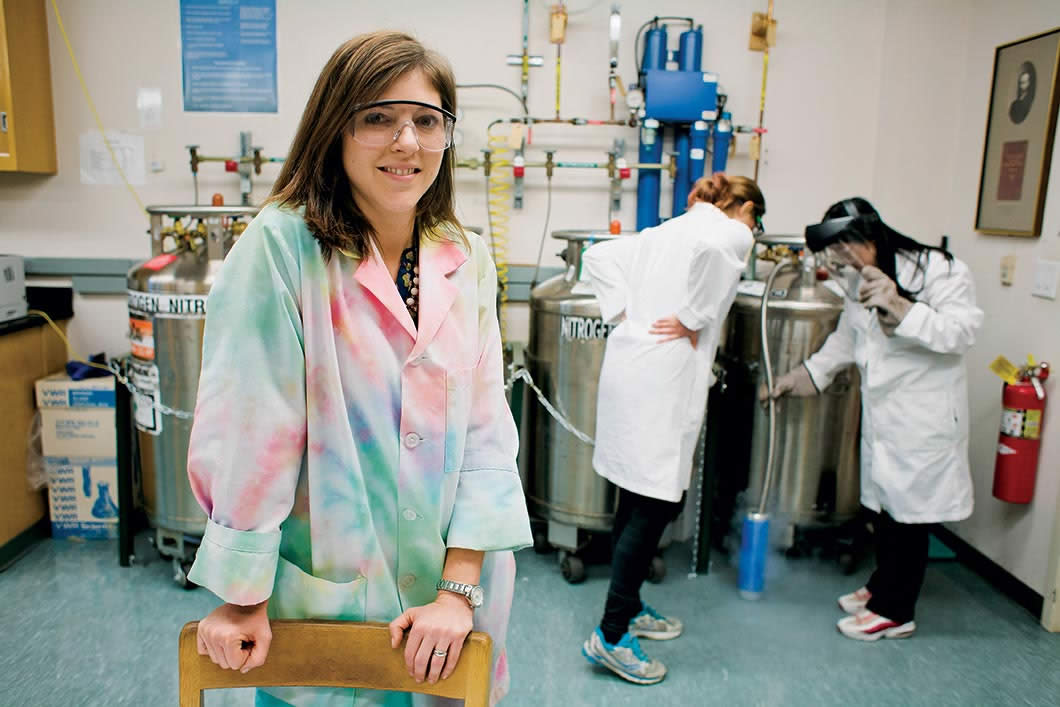Faculty
Clearing the Air
Chemist seeks to understand how pollution enables climate change
But for one stroke of luck, Earth could be minus a big ally in the climate change fight: Lelia Hawkins discovered atmospheric chemistry by accident.
“I always had a passion for science, initially biology,” says the assistant professor of chemistry. While an undergraduate in environmental science at University of California, San Diego, Hawkins took an elective in atmospheric chemistry—and was quickly hooked. “I fell in love with the idea that interesting, complex reactions were taking place in the air and that understanding them could lead to improved quality of life.”

Now, several years and one prestigious NSF Faculty Early Career Development (CAREER) grant later, Hawkins is examining the nature of particulate air pollution to better understand how particles interact with light—a key problem in addressing climate change.
The Hawkins Lab is measuring the UV/visible absorption spectrum of smog particles to see how secondary atmospheric brown carbon forms and transforms. Studying the persistence and nature of these formations, as well as the optical and chemical changes that accompany brown carbon aging, can elucidate brown carbon’s role in atmospheric warming and ultimately help to improve climate models. To help streamline the research, the CAREER grant provided funding for an aerosol mass spectrometer, a valuable instrument that measures the chemical composition of particles locally and rapidly.
“The chemical nature of secondary compounds is still very poorly understood,” says Hawkins. “Figuring out which compounds are responsible for the brown color of some particles has proven even tougher, since they represent an incredibly small, but important, fraction of material. This work will help us target those minor components by using frequent, local measurements of both composition and absorption extending over weeks to months.”
As an added benefit, the spectrometer affords her students the opportunity to use state-of-the-art instrumentation commonly limited to graduate work and industry.
“Having students use this equipment to understand chemical phenomena is truly rewarding,” she says. “It’s fun seeing them get excited about increased resolution, lower detection limits, faster response times, and seeing them gain confidence in operating sophisticated chemical instrumentation.”
And it’s essential training in the fight against climate change, the disastrous effects of which can be curbed, says Hawkins, but only if we act deliberately.
“One of the changes scientists worry most about is the melting of polar ice, because that is not a reversible system on any kind of timescale relevant to humans,” she says. “Once the ice is gone, we’ll need much colder conditions for a very long time to get it back.” She cites extreme drought in the developing world as another irreversible effect that could devastate populations for generations to come.
Beginning her sixth year at Harvey Mudd, Hawkins has worked alongside a sizable sample population of the next generation of passionate chemists and—luckily for us—believes they will rise to meet what has become an existential challenge.
“Students today don’t want to just learn the chemistry, or the physics, math and biology of the problem,” she says. “They want to understand why we have the problem. Our students are deeply interested in the societal aspects of the subjects we teach, and that is going to make them far more impactful. Understanding how some pollutant impacts the environment is nearly useless unless you understand how to effect change.”
Everyone deserves a healthy planet, and that includes clean water and clean air.
–LELIA HAWKINS, 2015 CAREER GRANT AWARDEE
Hawkins credits mentor Kimberly Prather, UCSD’s distinguished chair in atmospheric chemistry, for urging her to double major in chemistry and environmental science, equipping her with a breadth of knowledge to pursue complex graduate work in atmospheric chemistry and understand its impact on an increasingly global society. Now she’s inspiring her Harvey Mudd undergraduates to do the same.
“Everyone deserves a healthy planet, and that includes clean water and clean air,” says Hawkins. “The idea that one person, or one group of people, can impact the health of many motivates me to understand how air pollution forms and transforms.”